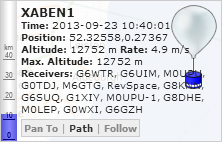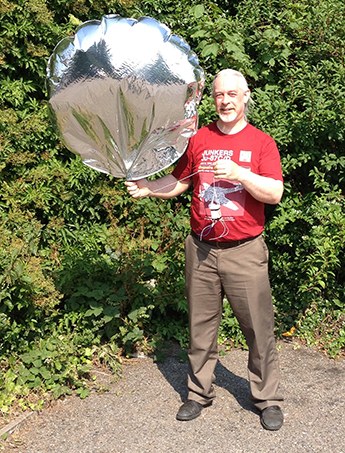Having sorted my login out and designed a logo for this project, I can continue.
In the early days of my interest in HAB I discovered the website Spacenear.us This site plots all the current flights of HAB’s around the world on Google Maps, at least the ones they know about. Usefully, there are information panels for frequencies and for current telemetry.
The colour for the payload is allocated by the website and is completely random. These panels were the actual panels for Steve’s (Radio Callsign G8KHW) flights on 23rd September 2013, flown as I wrote this entry. In the payload info panel, there is a link for the IRC channel #highaltitude on the freenode network. This is a great place to chat to HABers and learn all about the different facets of this hobby. Many experienced HABers congregate in the channel and it is worth a login just to sit and watch the conversations.
I was in #highaltitude on Saturday 7th July. Chris Stubbs (M6EDF) had launched a foil balloon with a small tracker. These are termed ‘Pico’ because of their size. I followed it’s progress and was pleased when it headed in my general direction. As it floated across the River Thames, the radio signal got louder and it’s course changed until it was coming directly at my location. By this time the foil balloon was falling in height and I started to scan the sky. I was amazed when I spotted a tiny dot coming my way. I reported this to Chris on IRC. He was very pleased I’d made visual contact. Quite by chance, a friend of mine, Ken, was visiting and I asked him if he would like to chase the balloon. He agreed and we sped off. The Spacenear.us tracker tries to predict the path and landing site of each payload so I had a pretty good idea of where Chris’s balloon would end up. It turned out to be a golf course in Bexleyheath. When we arrived, I asked for permission to look for the balloon and was allowed on to the course with the obvious safety considerations. After a good 45 minutes of searching and talking to golfers, I managed to recover the balloon and payload successfully.
During the coming week I posted Chris his payload and as thanks, he sent me an unpopulated circuit board and a few components which has become one of my first two trackers. Chris wrote a more detailed account of the flight on his website.
Shortly after this, Anthony Stirk (M0UPU) asked me to design a logo for his new project, the HabDuino. This circuit board is a ‘shield’ which fits on an Arduino and produces a ready made tracker. All that is left to do is to program the Arduino in the normal way and it is ready to fly. Details of the device and when it will become available can be found on Anthony’s website www.habduino.org As a thank you for designing the main logo, Anthony kindly gave me a Habduino and I look forward to flying it either later this year or early next year.
So this is where my first two trackers have come from. I have also begun to re-design Chris’s tracker. I have added a few facilities I believe to be useful. This will eventually be released under creative commons license (Attribution-Non-commercial-Share alike).


